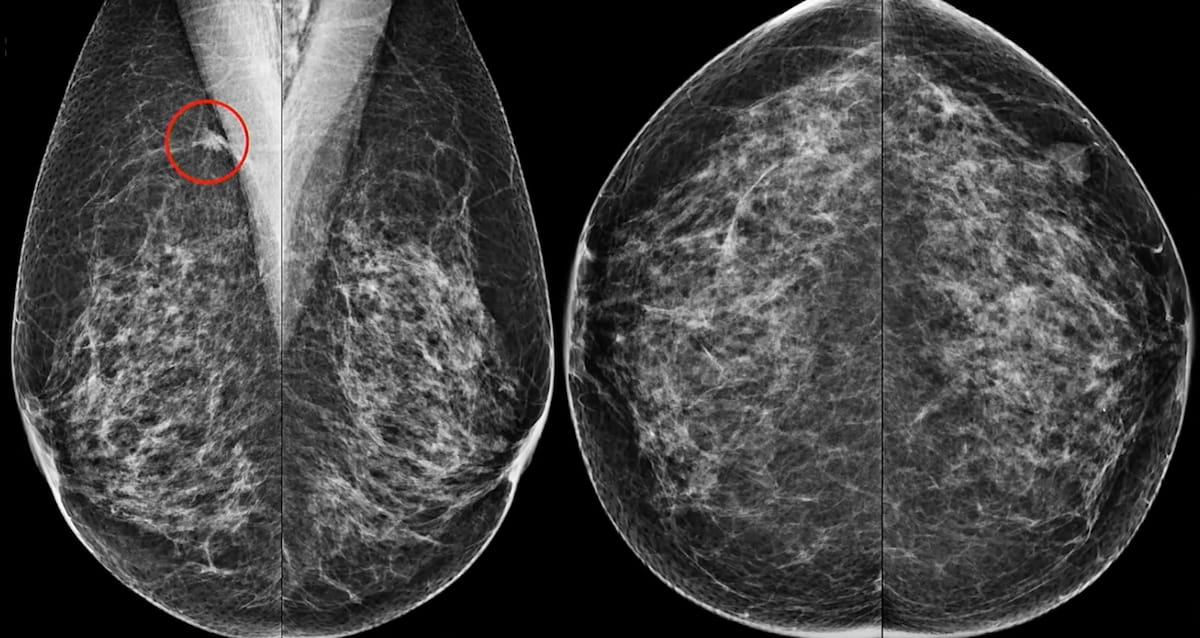Study: Contrast-Enhanced Mammography Changes Surgical Plan in 22.5 Percent of Breast Cancer Cases
Contrast-enhanced mammography detected additional lesions in 43 percent of patients and led to additional biopsies in 18.2 percent of patients, over half of whom had malignant lesions, according to a study of over 500 women presented at the recent Radiological Society of North America (RSNA) conference.
Emerging research suggests that contrast-enhanced mammography (CEM) can play a significant role in pre-op staging for women with breast cancer.
For the retrospective study, presented at the recent Radiological Society of North America (RSNA) conference, researchers reviewed data from 524 CEM exams (for 525 malignant lesions) performed over a three-year period from 2017 to 2020.
Utilization of CEM helped diagnose additional breast lesions in 226 patients (43 percent) in the study cohort, according to the study authors. Out of 96 additional biopsies (18.2 percent) triggered by CEM findings, the researchers noted that 52 percent revealed malignant lesions.1
The study authors emphasized that preoperative use of CEM led to changes in surgical management in 118 cases (22.5 percent). For 64 patients (12.2 percent), an initial plan of breast-conserving surgery (BCS) was changed to a mastectomy procedure, according to the researchers. They also found that 33 patients (6.3 percent) required more extensive BCS, and 18 women (3.4 percent) needed surgery on the contralateral breast.1
The use of contrast-enhanced mammography in the above case led to a diagnosis of invasive carcinoma of the axillary tail of the right breast in a 59-year-old patient. (Images courtesy of RSNA.)

“It is also important to state that no conversions to mastectomy were made on the basis of a false positive finding on CEM in our study,” noted Chiara Bellini, MD, a breast radiologist affiliated with the Careggi University Hospital in Florence, Italy.
(Editor’s note: For related content, see “Study Says Contrast-Enhanced Mammography Offers Comparable Breast Cancer Detection to MRI,” “Study Reveals Tradeoffs Between Contrast-Enhanced Mammography and MRI for Supplemental Screening” and “Does Timing of Imaging Affect Interpretation of Contrast-Enhanced Mammography?”)
For study participants with non-palpable lesions, CEM demonstrated a 92.4 percent sensitivity rate, a 95.2 percent specificity rate, an accuracy rate of 94.5 percent and an area under the curve (AUC) of 93.8 percent. The researchers noted even higher breast cancer lesion detection rates for those with palpable lesions, citing a 100 percent sensitivity rate, a 97.2 percent specificity rate, a 97.7 percent accuracy rate and a 98.6 percent AUC.1
“Symptomatic patients with palpable lesions benefitted most from preoperative CEM with a statistically significant difference,” added Dr. Bellini.
Reference
1. Bellini C, Migliaro G. A large-scale single center evaluation of contrast enhanced mammography (CEM) in the pre-operative staging of breast cancer. Presented at the annual Radiological Society of North America (RSNA) conference, November 26-30, 2023, Chicago. Available at: https://reg.meeting.rsna.org/flow/rsna/rsna23/RSNA2023/page/post-event-attendee-portal .
GE HealthCare Debuts AI-Powered Cardiac CT Device at ACC Conference
April 1st 2025Featuring enhanced low-dose image quality with motion-free images, the Revolution Vibe CT system reportedly facilitates improved diagnostic clarity for patients with conditions ranging from in-stent restenosis to atrial fibrillation.
New AI-Enabled Portable Ultrasound May Facilitate 50 Percent Reduction in Cardiac Imaging Scan Time
March 28th 2025Artificial intelligence (AI)-powered measurement capabilities provide key features with the Compact Ultrasound 5500CV device, which was unveiled at the American College of Cardiology (ACC) conference.
New Collaboration Offers Promise of Automating Prior Authorizations in Radiology with AI
March 26th 2025In addition to a variety of tools to promote radiology workflow efficiencies, the integration of the Gravity AI tools into the PowerServer RIS platform may reduce time-consuming prior authorizations to minutes for completion.
AI-Initiated Recalls After Screening Mammography Demonstrate Higher PPV for Breast Cancer
March 18th 2025While recalls initiated by one of two reviewing radiologists after screening mammography were nearly 10 percent higher than recalls initiated by an AI software, the AI-initiated recalls had an 85 percent higher positive predictive value for breast cancer, according to a new study.